Want to know an interesting fact!?
The rowing machine muscles used while rowing equal about 84% of the total muscles in your body!
Now what other workout machine can boast these types of numbers?
Rowing machines are known as a full body workout because they exercise every major muscle group and provide a fantastic cardiovascular workout.
Rowers can expect to burn anywhere between 400-800 calories an hour on average based upon their current fitness levels.
More on the calorie topic in my article about Burning Calories With A Rowing Machine.
Using a rowing machine is also great because it is low impact, meaning it is great for people with injuries and bad knees. Even pregnant women can row.
So what muscles does a rowing machine work? Being that it is an almost perfect piece of workout equipment the rowing machine muscles targeted are:
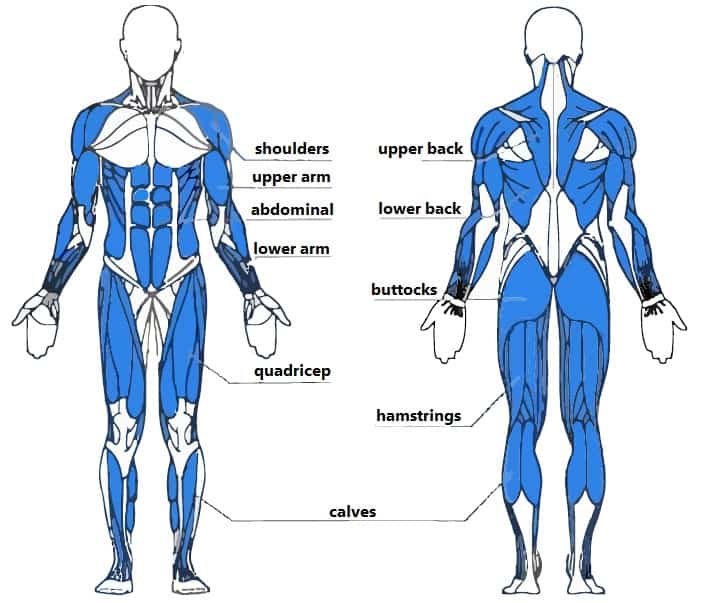
Plus it is one of the most extreme cardio workouts you can perform – so your lungs will be feeling it as well!
With all these rowing machine muscles used, it doesn’t surprise me that rowing has become increasingly popular in todays Crossfit style training environment.
Depending on how you train, you can row to increase you cardiovascular capabilities or use it to build strength and power.
4 Phases of the Rowing Stroke and the Muscles Worked in Each
When beginning to row you will learn there are four phases to a rowing stroke: Catch, Drive, Finish and Recovery. Each phase targets different muscle groups.
These photos illustrate the different positions.
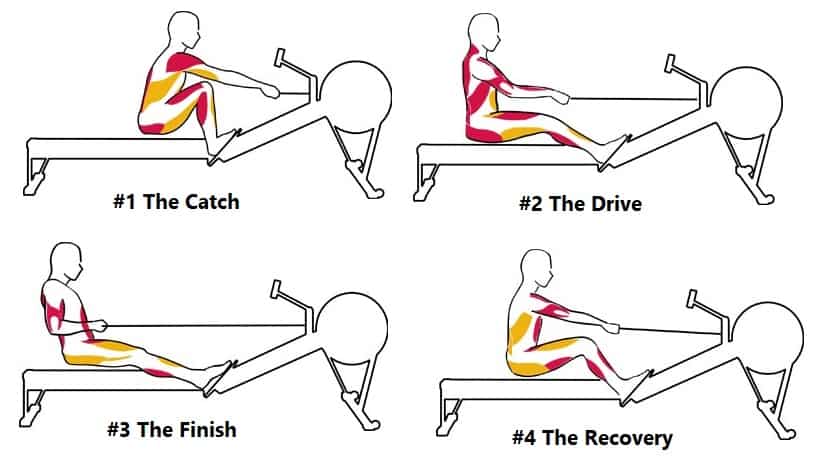
The Catch
A rowing stroke starts with the catch, where you position your body close to the front of the machine. To perform this motion, place your feet in the footplates and make sure they’re safely strapped.
To learn more about rower foot positioning, I wrote this article called “What Is The Proper Rowing Machine Foot Position?” which shows the correct foot placement.
Come close to the front of the row machine by bending your legs and using the power of your hamstrings, glutes, and calves. Your knees should be close to your chest, arms fully extended, and your shins vertical to the ground.
During this step, you’ll also be training your triceps and back muscles. Engaging your lats (latissimus dorsi) will allow you to properly extend your legs and rotate your shoulders.
Muscles trained: Calves, Hamstring, Glutes, Upper Abs, Lower Back, Triceps, Deltoids, Traps.
The Drive
The drive phase of the rowing stroke is all about powering the leg muscles and fully extending them. While firing up the glutes and hamstrings, you should keep your arms extended and your torso straight at a 45-degree angle.
The drive strengthens muscles in your lower body, in this case, quads, hamstrings, and glutes. As your body leans back, biceps, back, and shoulder muscles contract as well.
Muscles trained: Glutes, Hamstring, Quads, Calves, Deltoids, Traps, Upper & Middle Back, Biceps, Forearms, Abs, Forearms, Delts, Lats.
The Finish
The third phase of a stroke is a short but very efficient motion called the finish. While keeping your core tightened up, you lean backward by 5 degrees max. The motion is complete when you pull the handle towards your ribcage or chest. Here your upper arms will internally rotate, mirroring the rowing motion.
Muscles trained: Glutes, Quads, Rectus Abdominis, Internal Abdominal Oblique, External Abdominal Oblique, Pyramidal, Transverse Abdominis, Traps, Posterior Delts, Biceps, Forearms, Lats.
The Recovery
The goal of the recovery phase is to return to the initial position of the stroke.
A lot of stabilizing power is required to finish the rowing stroke as the resistance in the rower’s flywheel will oblige you to hinge forward. With the handle in your chest, it’s time to let go and extend your arms, keeping them parallel and engaged.
As you bend your knees, you’ll feel all the activation in your back, core, and shoulder muscles. This phase is paramount to effectively strengthen the rowing muscles if you stay in control of your movement and perform it slowly.
Muscles trained: Hamstring, Calves, Triceps, Traps, Delts, Forearms, Abs.
Here is a quick video of the rowing stroke
As you can see the rowing machine muscles used during the 4 phases are just about every muscle in the body! It would probably have been easier to just name the muscles it doesn’t target.
Just by performing a basic rowing stroke, you will target all of these muscle groups.
Are Rowing Machines Engaging Your Core?
Yes, rowing machines engage your core. Usually, when you row, your rowing workouts engage your abdominal muscles the entire rowing time. And this is essential to prepare your other muscle groups for the intense workout against the resistance created.
Since rowing engages your midsection muscles and is a terrific fat-burning activity, you can expect your midsection muscles to be lean with time.
With rowing, even for a few minutes a day, you will ignite the metabolic furnace, which will burn all fat deposits in major muscle groups to the ground.
As a result, your toned and strengthened midsection muscles will be what to show for an excellent rowing machine full body workout.
Since engaging your core and strengthening the muscles in your midsection is what a rowing machine does excellently, you want to incorporate rowing into your daily training.
How Long Should You Work Out on a Rowing Machine to Tone Your Core Muscles?
You will row for 30 minutes to tone your core muscles. Rowing for 30 minutes daily on your rowing machine will strengthen your core muscles. Also, this rowing session is sufficient to yield results in your upper and lower body.
If there’s one advantage of working out on a rower, it is delivering a full body workout. That also means your core muscles benefit from your rowing workouts.
The worked core muscles during a rowing session include your abs, obliques, gluteus, and lower back muscles.
Your rowing machine works your core muscles right from the first stage: the catch. The ergometer works your abs and the lower back in this first rowing stroke phase.
What’s even more incredible is working out for only 30 minutes daily yields astonishing fitness levels.
The drive phase also works core muscles; this time, it focuses on your glutes. Also, this stroke phase works your glutes and abs, especially during the body swing emphasis.
Additionally, the finish and recovery phases also work some core muscles. You can engage your core and work its muscles excellently by working out for 30 minutes a day on your ergometer.
So, consider rowing for at least 30 minutes daily to ensure critical core muscles work for an astonishing fitness level.
Does Rowing Also Use Heart Muscles?
Rowing gives you excellent cardio workouts. Rowing on your ergometer uses up to 86% of muscle groups. With more muscles used, more oxygen needs to reach the muscles.
As your heart pumps harder throughout the rowing session, it works its muscles to build endurance.
As a result of rowing on your erg, your heart rate will increase to meet the demand for more oxygen by the worked muscle groups. And that’s how rowing benefits you with cardio workouts.
Rowing doesn’t use your heart muscles directly. But it initiates cardio workouts to benefit your heart muscles. And the result of working on your rowing machine shows your toned body muscles and great cardiovascular health.
Can I Also Lose Weight from a Rowing Machine?
Absolutely yes, you can also lose weight from rowing besides working various muscles such as those in your upper arms and upper bodies like your shoulder muscles. And that’s because rowing boosts calorie burn.
What’s more impressive is that working out on a rowing machine burns the same calories as running while remaining a low-impact exercise.
But you want to reduce your calorie intake to boost the calories expended. And this is how you lose weight while rowing on your erg.
Does Increasing Rowing Intensity Workout Increase the Fitness Level?
Yes, increasing your rowing workout intensity will boost your fitness level. But this is after working out at lower rowing intensities.
You want to work out at moderate intensity when starting your rowing sessions. And that’s because a moderate intensity keeps upper bodies, such as your shoulder blades, engaged while allowing you to hold a conversation.
Since you want to start rowing at a moderate intensity, set your rower’s damper setting to 3 – 5. Once you’ve worked out enough and want to boost your fitness level, you can set the damper to 8 – 10, with 10 being the maximum workout intensity.
But setting your rower at high intensity increases the resistance, and you will use more effort to counter resistance. So, rowing at high intensity means using more effort and building muscle groups.
Therefore, consider working out at high intensity to strengthen muscles for an impressive fitness level.
Does Rowing on an Ergometer Also Train My Latissimus Dorsi?
Yes, rowing on a rowing machine also works your latissimus dorsi. Often referred to as lats, this muscle connects your upper arm bones to your spine and hips. Usually, pulling the handlebar to your lower chest in the finishing phase of the stroke uses your latissimus dorsi.
Specifically, you will pull the handle with your shoulder blades squeezed together. However, you want to maintain a proper rowing form the entire time to work your lats better. Since rowing machines use your lats, they work your back muscles and strengthen other muscle groups.
Final Thoughts
I’m sure you already guessed it, but I’m a huge proponent of the rowing machine. I feel it is one of the best all-around pieces of fitness equipment and they are great for home-use.
The rowing machine uses almost every muscle in the body while still giving a great cardiovascular workout! This leads to losing more weight, building more lean muscle, and saving you time!
For more informational articles like this one check out my Rowing Machine Articles section.
I have a great article called Will A Rowing Machine Help Me Lose Weight? which may also interest you.
Plus, another article answering the questions, What Does A Rowing Machine Do For My Body?
If this article helped convince you the rowing machine targets enough muscles and you want to buy one, then check out my best home rowing machine picks here.
I hope you enjoyed this article and if you have any questions please leave me a comment below! I love answering your questions so don’t hesitate to ask!

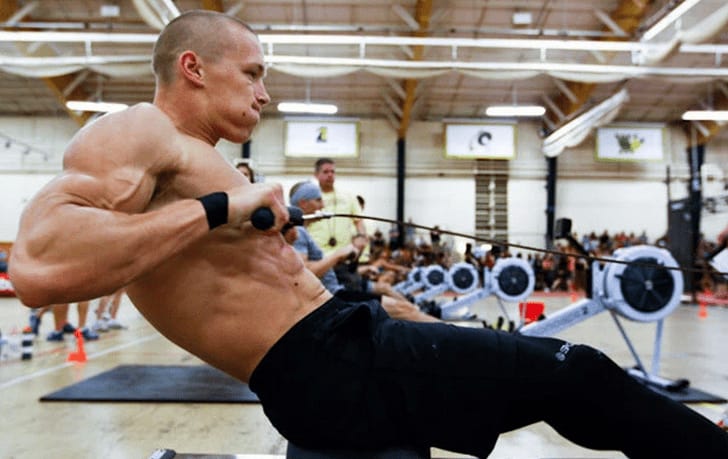
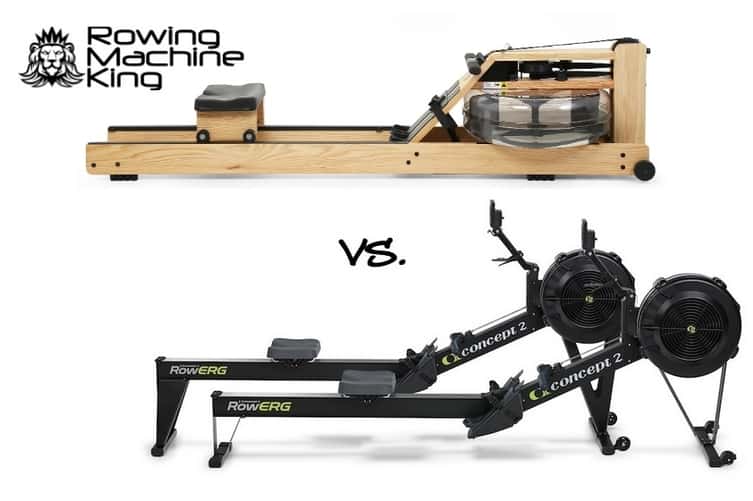
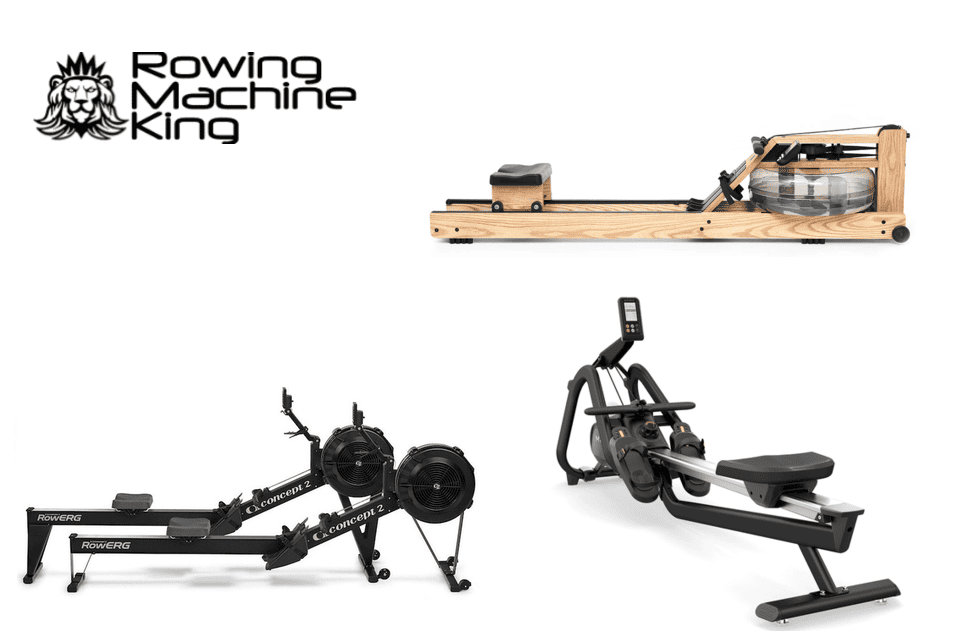
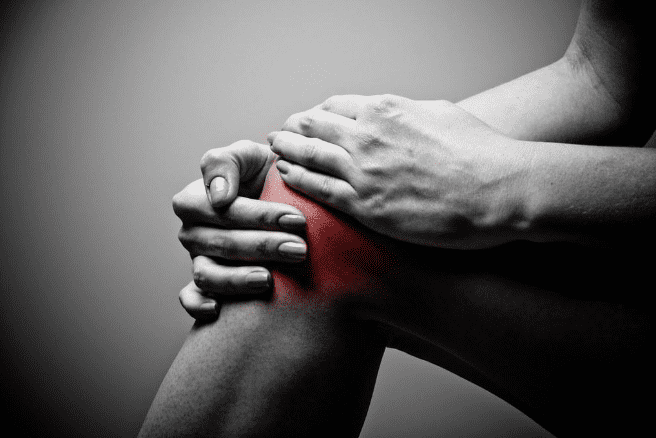
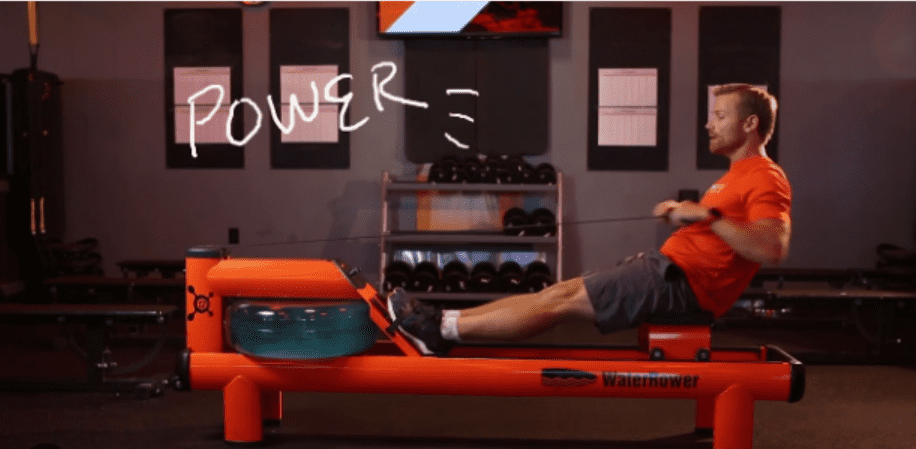
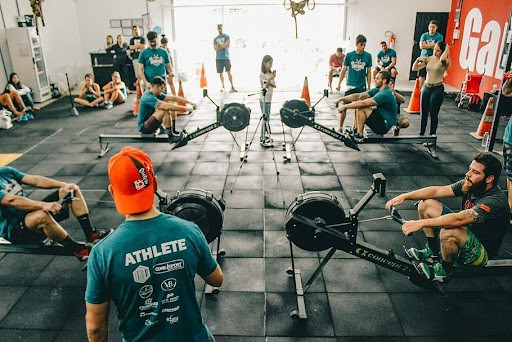
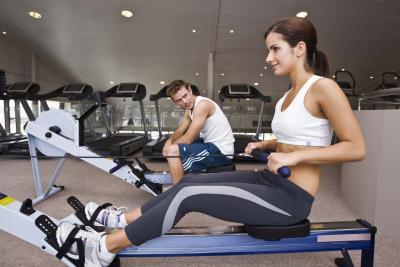
Hi Edwin
i use a rowing machine to build a bit of muscle, as much as anything; with the added convenience of keeping fat off.
I wondered whether, specifically, the rowing machine worked the lateral deltoid and trapezius head / upper trapezius…?
I know it works the deltoid a and trapezius generally, but I wondered if it specifically works these parts of the overall muscle.
Thank you
Richard,
Great question! There have not been any studies conducted that state rowing specifically targets the “lateral deltoid” or the “upper trapezius”. When doing some research I tried to reverse engineer if a rowing machine would specifically target these areas by looking at “The best workouts” for each muscle group. If the best workouts for these groups mimics the rowing motion then I would say rowing specifically targets these muscles.
For the “lateral deltoid” many health experts claim that any shoulder workout would target the lateral deltoid in some way. The best workouts would then look something like “lateral dumbbell raises”, “military press”, “upright rows”, “front arm raises”, etc. While a rowing motion is not specifically stated, I believe 3 of these workouts can easily be performed with a rowing machine and supplemented into your workouts. You can stand over the fly wheel and use the handle to perform “upright rows”, “lateral raises”, and “front arm raises”. You can also just buy some cheap dumbbells and superset these into your workout.
The same goes for the “upper trapezius”. The best workouts would be “shrugs”, “inclined shrugs”, “barbell row”, etc. These workouts mimic more of the rowing style form and can be done while rowing. I would recommend changing the elevation at which you are pulling back the handle to hit different areas of your traps. To target your upper traps I would incorporate pulling the handle higher up on your chest and even pulled the handle to the level of your chin. You can also do some variations with standing in front of the rower and using the handle/flywheel to do different workouts.
I hope this information was useful Richard! Just rowing will definitely work your lateral delts and upper traps but if you want to specifically target them try some of these workouts. Also, maybe invest in some cheap dumbbells or kettle-bells and incorporate those into your workouts!
Cheers and happy rowing!
Hi I’m extremely unfit and morbidly obese and have been advised by my doctor to lose weight currently I weigh 140kg how should I begin and what resistance would you recommend to start with
Thank you.
Hi Colin – thank you for reaching out! I think the best recommendation is to just start! You will figure it out as you go.
I would put the resistance on “medium” to start, whether that is a 5 on the Concept2 or resistance 4 of 8 on a magnetic rower. Then just row at a “medium” pace until you feel tired.
As you get into a routine you can begin tracking time, distance, and calories. The beginning of your journey should be learning proper form and getting into a daily routine.
Hope that helps!
Hi there! Thanks for the article! Can I ask where you found the 84% muscle used stat? Thanks!
Hi Meg,
Great questions! Over the years I have seen the line, “rowing uses 84% of muscles used” countless times so it is just a number ingrained in my head.
I have seen this number used in publications by WaterRower, CityRow, and BreakingMuscle. The creators of Indo-Row have also claimed rowing uses 84% of your muscle mass.
I tried searching the white papers listings to get a scientific study I could source but my search came up empty. The closest citable source I could find was from the book, “Handbook of Sports Medicine and Science, Rowing” that claims 75% of the total muscle mass is used while rowing.
I hope this answer helps!
I’d be grateful to hear your advice on a question about using a rowing machine for HIIT. I have read that, because there is a brief recovery period on the move forwards, the action is not continuous as it would be if one was using an exercise bike and that this, therefore, detracts from the high intensity. I’ve been using the 8X(20 sec row/10 secs rest) protocol, following a 2 minute warm-up and getting my heart rate up to between 80-90% max (I’m a 65 year old, fit woman). Am I wasting my time doing this or will it still have the health benefits I’m hoping for?
Caz,
Could you post the link to the articles you are referring to? I would be interested in reading their opinion.
In my opinion rowing machines are one of the best exercise machines to use for HIIT because they incorporate the entire body. The whole point of HIIT is to get your body to about 80%-90% of your maximum heart rate and keep it there for a certain period of time. You then perform the exercise for another set period of time at around 40%-50% of your maximum heart rate. As long as the “recovery period” you mentioned doesn’t drop your heart rate below the 80-90% window then you are still performing a HIIT exercise.
Exercises that can increase your heart rate quickly and transition to a light workout easily are usually the best for HIIT. A rowing machine can provide exactly that. There are literally hundreds of different ways to perform HIIT exercises as long as the heart rate guidelines are met. Performing an exercise you enjoy doing would probably work best since HIIT exercises become very difficult and “not very fun”.
I would say that there is definitely nothing wrong with using a rowing machine for HIIT and you are definitely not wasting your time. Exercise bikes can also be used for HIIT but the muscles used are more focused on the legs. This means the cardiovascular benefits would be the same but your upper body would not receive the benefits of increased lean muscle mass.
If you have access to an exercise bike then try both and see which one you prefer!
Thanks for the advice – that’s reassuring! I’m hunting for the link to the comment about the recovery between strokes but haven’t yet found it – will keep looking. I do wonder if I’m doing the whole thing correctly, however. I have an old rowing machine a V-Fit MR2, inherited from my son, and it’s not very high tech. The resistance goes up to 5, whatever that means, so I tend to keep it on 3 for HIIT so I can row as fast as possible. However, I find that, whilst my heart rate goes up to about 140 and I feel a bit puffed, I’m not as wiped out as it seems I should be, according to descriptions I have read which say you should feel as if you can’t go on. Although pretty fit, I don’t believe I’m at the top of my game so perhaps I’m not doing it properly. I don’t have an exercise bike though I could try it at the gym but actually really prefer rowing.
Just make sure you are calculating your 80-90% max heart rate properly and maybe try doing other versions of HIIT. If you don’t feel wiped out then try doing intervals of 1 minute high intensity and 30 seconds low intensity. There are many variations of HIIT that you can try, just find one that works for you.
Hi, Just found the link that suggests rowing might not be suitable for HIIT http://boxlifemagazine.com/the-6-best-tabata-workouts-the-2-numbers-that-matter-in-any-tabata-workout/ See second paragraph ‘What makes a movement unsuitable for Tabata’.
Hope it’s wrong!
Hi Caz,
The article says that rowing may not be suitable for “Tabata” which is a specific type of HIIT exercise. Here’s a good article explaining Tabata vs. HIIT exercises.
I still think rowing is a good exercise for HIIT along with many other professionals. I know you have your doubts ;)
I think the other exercises mentioned are great as well and may work better for the 20/10 protocol. Like I said, find what works best for you and stick with it!
That’s for the article though! Always good to hear other opinions and share information :)
Yes, thanks, definitely calculating properly but will keep going on the same version but perhaps raise the resistance – would prefer to keep it short intervals.
Hi, I have had shin splints on my left shin, and very sore feet after years of walking/hiking. I bought a rowing machine to give my feet a rest. Will the shin splints be less likely to recur using the rower than to keep walking so intensely? Thank you
Hi Ros,
Sorry to hear about the pain you have been experiencing. Your question is tough to answer because shin splints can mean a lot of different things. It is mostly associated with doing “too much, too often” or basically increasing mileage too fast. Shin splints can also be cause by “compartment syndrome”
Most doctors would recommend a person to decrease the amount of activity they are performing and make sure to stretch and apply ice.
There are not many cases where rowers experience “shin splints” so I would believe that the low-impact nature of rowing reduces the chances of experiencing this pain.
If you continue to feel pain you will have to look deeper into the cause. It could be “compartment syndrome” like I mentioned or an imbalance of muscles in your lower leg which can be fixed with various exercises.
Sorry I could not give a more direct answer but I guess the best thing to do is try rowing and see if the pain goes away.
Hi thanks for an informative article.
I have just had an MRI scan that shows the lower 2 lumber joints (L4& L5) with seriously reduced muscle fibre.
Will a rowing machine build the muscle around these joint back up & converr the fatty tissue into muscle fibre?
Regards Chris
Hi Chris,
While a rowing machine does work out the lower back muscles I am not sure about building muscle around your L4 and L5 lumbar joints.
I know the L4 & L5 are pretty commonly injured but this is really something you should discuss with your doctor or office who gave you the MRI. I would assume that rehabilitation would also have to take into account how the injury occurred.
Maybe some research about how to strengthen the L4 and L5 could give you a better idea if a rowing machine will help. This article on spine health may be a good start.
Thanks very much for your reply & the link you sent me.
I’ll have to do some more research & probably look at a rowing machine later.
Kind regards
Chris
I am wondering about the effect that a rowing machine would have on a senior’s knees My wife has one artificial knee and my knees are suspect at times
Bob
Hi Bob,
Unfortunately each case is different and everyone reacts differently to rowing. There are many people who have had various types of knee problems (arthritis, tears, surgery, replacements) that say rowing has greatly benefited them. They claim that it is the only sport they can perform and has helped their knees perform better overall.
Then there are others who were hopeful about the benefits of rowing but found it to irritate their knees the same as running and other activities.
The only real way to know is to experiment and see the results. Hopefully you have a fitness center near you with a rowing machine that you can try a few times to see if it is something worth investing in. There are also a few techniques rowers use to limit the stress put on their knees like rowing strapless or shortening their stroke.
Good luck and let me know if you need anything else!
Hi great article! I’m a dancer and have been rowing now (on a machine) for 3month to increase my stamina, strength and endurance. I have certainly noticed the benefits of rowing! I’m stronger during partnering work and when doing solos I no longer feel like I’m about to collapse to my knees and call for oxygen from the stage wings.
My question is does rowing target the quads equally? Many injuries occur to dancers due to quad imbalances and specifically weak vastus medialis compared to the outer quad muscles. My concern is whether by doing rowing I’m creating imbalances in my quad mucles and if I should do other exercises to target the inner thigh muscles to rebalance them. Thanks
Hi Shahid,
Glad to hear rowing has helped you improve as a dancer! Rowing is an excellent exercise to cross train with and I think many people could benefit like you have.
Rowing on an erg is a lot different than rowing in a boat and helps to decrease any muscle imbalances (left vs. right) so you have no worries there. As far as quad specific muscle imbalances, I have not heard of anyone experiencing this from using an erg. Rowing on an erg is a lot like doing a leg press which will specifically target the quads. Your vastus medialis “tear drop” muscle will definitely be targeted while rowing and you will see many professional rowers with a well defined “tear drop”.
However, in my opinion doing any one activity repeatedly will lead to some muscular imbalance. There is no perfect workout where every muscle gets worked evenly. If you are nervous about not having a strong enough vastus medialis then you can perform more lunges, leg extension, or step-up workouts. You can also google “vastus medialis workouts” for more ideas.
I always like to recommend rowers to cross train with other full-body exercises like kettle-bells. It is also a good idea to work in some lateral movements with weights like “side lunges” since rowing will not specifically target these muscles. Doing different kettle-bell exercises will help add some strength nd ensure you don’t create any imbalances.
I hope this helped and good luck!
Hi, I have started rowing machine and so far I love it. I just want to know that would rowing machine help in having strong biceps? I mean would I notice the change in my arms and biceps? Also how long will it take when I’ll actually start to notice the change in my body?
Hi Shariq,
Glad to hear you’re enjoying rowing! Rowing will definitely work the arms and biceps but it will not compare to doing an isolated exercise like bicep curls.
After rowing hard (on a Concept2) I feel my arms are “tight”, so there are definitely muscle fibers tearing and growing (how muscles get bigger).
I would continue rowing your normal routine but afterwards try to do an isolated exercise like bicep curls and pushups to target your biceps and triceps. If you don’t have weights just through some heavy stuff, like books, in a bag and curl it as many times as you can. You should feel your arms get “tight” after a workout and should see results within a few weeks.
Hope this helps!
Thank you so much for your reply. Yes I do feel that my biceps get pretty hard or tight after rowing for 30-45 mins. The main reason to start rowing machine was that I wanted to lose weight. I’m 22 and I weigh around 179lbs. I’m aiming to lose 25 pounds in 4-5 months. Is the rowing machine and diet alone good for achieving this goal? I heard that rowing is that best machine and most effective as compared to other machines. I’ll be waiting for your reply
How tall are you currently? I would say the goal is definitely possible but it depends a lot on your body fat percentage. If you are tall, then 25 lbs is a lot to lose.
I would judge results more on how you look and feel rather than how much you weigh. Since you were asking about having bigger arms and biceps I’m assuming you want to put on a little muscle. Muscle will weigh more than fat so even if you lose fat and gain muscle it may not show your improvements as much while looking at your weight.
You are right, may be losing weight is not the right objective. I want to get fit. My height is 5’10. I want to look fit which currently I’m not. I have belly fat, and manboobs as they say it. Do you think it’s possible to lose belly fat and manboobs through rowing machine? (Concept 2) I’ll be waiting for your reply
Yes, those goals are definitely possible. I 100% recommend to do pushups after each rowing session to help build your chest muscles. They are a great full body workout that targets chest, triceps, back, and core.
Thank you so much! So basically I have to continue rowing and control my diet with push ups every session and I’ll achieve my goal? Also, I use rowing machine thrice a week and I’ve been increasing calories burned, is this enough? Or should I increase number of days?
Yes, that is a good place to start. I would try to get a workout in 5-6 days a week.
Hello, Rowing looks good for muscle maintainence ,I am disabled with no memory you can see I don’t remember how to spell. I will do push-ups,triangle push-ups and chin-ups 3 days a week. I don’t know what muscles I am missing. What would you recomend, I am 63 years old, my core is strong. Would you row 3 or 5 times a week, Thank you
Hi Roger,
Your spelling looks good to me! I also think you nailed it with your workout routine.
A combination of rowing, push-ups, and pull-ups will cover all the muscle groups. You said you have a strong core but you could add some core exercises in there like planks or sit-ups.
I think rowing 3-5 times a week is perfect!
Just keep doing what you’re doing! Keep me updated with how your progress goes.
Hi Edwin,
I am writing some thing for my university about how muscles work in rowing, can you please send me references from were you get that good info.
Thanks, Elīna
Hi Elina,
I’m glad you enjoyed my article on rowing machine muscles. Some sources I cannot recall specifically but here are a few you can reference for University:
You can also visit and search for “Rowing” + “Muscles” or other keywords for different scientific studies on rowing and ergometers.
Hope this helps!
Hi, I’m puzzled! I read in a newspaper article about rowing that to row 2000m in 8 mins at approx 30 strokes per minute is a good aim for a novice. I have an ancient V-fit MR2 machine and on the primitive display it has counters for distance, calories, speed and time. If I row at resistance 2 (max is 5) at approx 35 strokes per minute (I have to count them myself, obviously) for 8 minutes non-stop, I find I have only covered about 750m. I’m sure I have the technique right so have I got something wrong here?
Hi Caz,
This is more than likely just an issue with your monitor. Most monitors cannot record distance very accurately and a lot of them just use an estimate.
Only higher-end rowing machines can record distance accurately like Concept2 and WaterRower. This is also why these models are a lot more expensive.
I’m sure you have proper technique and if you feel you need a refresher just watch some technique videos on YouTube.
One thing you can do is use your current time and distance to use as a comparison. Next time you row try to beat 750m in 8 minutes!
Hello
I am playing volleyball with some friends and I am wondering if rowing will help me to increase my vertical jump. Thanks
I think it may help a little but I feel there are other workouts which are effective at increasing vertical jump. I would search this question on Google to find some more exercises.
I feel doing heavy squats, power cleans, and plyometric exercises can help. Also doing calf workouts, jumping rope, and maybe sumo jump squats.
Hi. I really liked the article. I’m just unsure of something. I have some equipment at home. And I’m going to start working out. One thing that has stopped me from making progress in the past is over complicating things which really stresses me out. So I’m going to make a really simple workout plan.
So the question is. Can using a rowing machine build muscle. And if so how should I use it to build muscle. I’m not talking about getting huge. But I’d like to see my back toned and with a noticeable size increase. I’m about 6’3 and quite skinny.
I’d really appreciate a response and if you have anything to add I’d love that.
Thank you for reading this.
Hi Jackson,
I think you are overcomplicating it already lol. The first thing to do is start. You don’t need a plan to start. Once you get into a routine of rowing everyday or every other day, then you can have a plan on ways to build muscle.
With that being said, I think doing HIIT training or sprint exercises is the best for shocking your muscles to grow.
I am thinking about buying a rowing machine — but before I do I would like to know if rowing would target Visceral Fat?
I’m not sure if it will target it specifically, but rowing is great for your core and should help burn fat in your mid-section. In my opinion, it will target it better than a bike, treadmill, or elliptical.
What muscles are the 16 percent that the rowing machine does not work out?
Good question! To be honest, I’m not sure. I’ve only pulled the stat from different white-papers I saw online and they only listed the muscles used. I have never seen a list of muscles not used.
My husband and I are working hard at losing some weight. He is 60 and I’m 63 yrs old. He has about 50-60#’s and I have an easy 60-80#’s to lose. We have set a goal to buy a Harley Trike when we’ve both reached 50#’s off! :-) So far so good with 10# off in two weeks for each of us. He currently rides a recumbent bike indoors which I know only works his legs. I don’t work out at all, but know that I will eventually need to. We are mostly working on our eating at this point to get into a good routine of healthy foods.
I think a rower would be a good workout for both of us for our next move. We want to be able to work out in our home. We have other “un-used” equipment like a treadmill, a mini trampoline and small weights and many sizes of bands from various visits over the years to the PT. I can see the rower being a great all over body workout for me as I dislike switching things around and figuring out which exercise I should be doing this day or what muscle to be working on, and getting in and out of the bands to do an exercise, etc. For him, it would be similar in some aspect to what he is doing now and wouldn’t add complicated figuring out of how to do all those other exercises. (he’s reluctant to major changes). A rower just seems like a good fit for both of us.
A couple questions however….
Will a rower bulk up muscles? For me I do not want to build big muscles, just get fit, lose more weight, and be toned and a bit stronger.
For him…he has Ankylosing Spondylitis and his spine is has pretty much fused over time and has limited flexibility. He has a severe bend in his upper back due to it, making him look like he has super bad posture. He used to ride the recumbent outside also because it provides back support and gives him the ability to have good visuals on traffic compared to riding a traditional bike that tends to keep his head facing the road under him, since his next has very limited flexibility.
Do you think a rower will work for him and still be beneficial? In video’s I see rowers sitting very upright and wondered if that would work for him since he can’t do that.
Thanks much for the information in the article and soon the answers to my questions!
Hi Deborah,
Glad to hear you are having some success losing weight and have set some great goals! I do think a rowing machine would be a great fit for you and your husband.
One idea would be to buy a 2-in-1 recumbent bike / rower. This way you have both machines and one that your husband already likes. If you want to try a traditional rower I would visit a fitness retailer first before investing in something you aren’t sure will be comfortable.
You can check out a popular recumbent/bike rower here. I also see you filled out my form and I will respond to you there in more detail.
I’ve recently started working out on a rower. I have a hard time keeping my back straight during all phases of the row. Any tips/advice? I’m a 5’1″ female. (Thanks for all the great info on your site.)
Hi Ava,
Glad to hear you found my site helpful! As for keeping your back straight, I don’t know any great secrets. I just try to focus on keeping my core engaged and back straight. I also like to make sure I’m not “reaching” forward and bending too far forward at the hips. I also make sure that my shins never go past vertical and always try to keep my feet connected to the footrests (i.e. make sure my heels don’t lift off too much)
Looking for comparison of standard rowing machine and the TOTAL GYM INCLINE ROWER. Which is best for full body workout. Is the incline and using body weight for resistance good or would the standard machine like CONCEPT 2 model E be better for 68 yr old man.
Hi Marcus,
I am not sold on the Total Gym Incline Rower and would 100% go with a Concept2. The Concept2 is proven to be the best home rower on the market and is used by every Olypmic/Collegiate rower and is seen in all Crossfit gyms. The proof is in the pudding…you wont’t see a Total Gym Incline Rower being used by any real athletes.
Just my $0.02 but I think the Concept2 is the Gold Standard for anything related to a rowing exercise.
What exercises are complimentary for those muscles not highly involved in rowing? For example, I don’t feel I am getting much benefit to the triceps as the final of the 4 phase is just recovery against air.
Thank you for such a fine article and great responses to questions.
Hi Nathan,
The best complimentary workout to rowing is push-ups in my opinion. This works out the chest and triceps which are secondary muscles used during rowing. Plus, they are another full body workout and super easy to do if you just jump of the rower, perform a set, then start rowing again :)
I have been dealing with impingement and frozen shoulder and have been in therapy for 6months now and will be for some time yet.My therapist just gave me the clear to start with (baby steps) going back to the gym. Over the years I have been very active in the gym and had really good upper body muscle until I injured my shoulder and have seen the decline of muscle. Does rowing have the benefits to build muscle and strength in my shoulder again?
Hi Barb,
The rowing machine does work out the shoulders but it really depends on what area of the shoulder you want to focus on. There are so many different exercises you can do to target different parts of the shoulder.
I would ask your therapist what they think and try a rowing machine out at the gym to see if it gives you the workout you are looking for :)
I’m a very young 68 yr old woman and I am on a weight loss journey with a special eating program designed to watch my proportions and to eat healthy. The gym I joined has a rowing machine and that’s exactly the machine I wanted. I am totally committed to getting in the best shape of my life with toned arms legs and core, everything on my body. I start tomorrow March 13th 2019. I’m worried about saggy arms and legs and such all over my body this is I hope where the rowing machine comes in. I want a lean toned body with some definition in my arms and legs as well. What should I do to start out and would it be ok if I did it everyday?
Hi Yvonne,
I think the best thing to do is watch some rowing technique videos on YouTube and just start rowing! Don’t overthink it! Try rowing for 20 minutes straight and if you feel ok to row the next day, then go for it! The best thing to do is to listen to your body and rest when you feel sore.
I have an article about if it’s ok to row everyday that you can read here.
Hi Yvonne,
I’m a ‘young’ 69 year old with a history of lots of exercise from ballet, squash and other stuff and have been using my rowing machine for a couple of years in conjunction with gym work and pilates and I really enjoy it. I just wanted to message you, not so much about technique etc. which I’m sure others more expert than me can do, but about the ‘saggy arms and legs’! I do press-ups and squats every other day (as I understand the muscles need a break to repair from the exercise) and I have strong legs and arms with fairly defined muscles. However, I’m really disappointed to find that I still have saggy skin, even though I have never been overweight. I think this is simply age-related loss of collagen and elastin in the skin. No creams etc. help either. Perhaps you’ll find differently (if so, please let me know what you’re doing!) but good luck with it all – you’ll certainly be healthy as a result of all your efforts anyway.
Great article on the 84% of muscles that are used. What are the 16% that are not, and what exercises address those and supplement the rowing?
Hi Jeff!
Thanks for reaching out! The 84% stat is quoted on a few studies but it doesn’t say what the 16% are that aren’t used! I wish I had that information as well!
I think the best way to look at it is that rowing is a pushing (legs) and pulling (arms & back) exercise. This would tell me the best supplement exercise would be to do a pulling with legs exercise (leg curls) and a pushing exercise for chest/shoulders (push-ups, front/side raises).
Pull-ups and functional kettle-bell exercises like Turkish get-ups and kettlebell swings are also great!!
I like the rowing machine at the gym. BUT, I don’t feel it does anything for the triceps. The triceps are only engaged in the recovery when there is no tension on the move itself. Am I wrong?
Hi Nathan,
The triceps are not hit as a primary muscles and I would recommend adding in push-ups to target the triceps and chest
Thanks Edwin. That’s a good way to look at it and I’ll add some of those push & pull exercises.
Hey there, I am a rower myself and i would like to ask what muscles i have to train in the gym to become a better rower. I already do full body workouts but I would like to focus on the more important muscles used for rowing.
Hi Robrecht – thank you for reaching out!
I think there are a low of exercises that translate well into becoming a better rower but if I had to pick 3 it would be power cleans, deadlifts or squats, and seated rows.